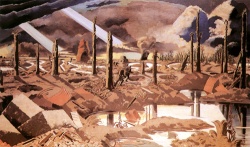| |
Paul Nash, The
Menin Road (1919)
 |
The very title of this painting is ironic, as no such thing as a road can be detected. The tree, a traditional symbol of strength and regeneration, has been transformed into black and burned stumps of destruction. Luxurious foliage has been replaced by forms which are vaguely reminiscent of floral elements, but are in fact barbed wire (foreground, left). Rays of light breaking through clouds are a traditional element of Romantic landscape painting (see C.D. Friedrich); however, Nash transforms those iconographic elements in a way that signifies an additional threat to the last soldiers scattered in the rugged landscape.
The rays of light in the pointing are ambivalent and may not only show sunís rays but also the light of bomb detonations (note the clouds at the end of the rays, which could be explosions of bombs). The light could also originate from planes (searchlights). Heaven and earth are only connected by destructive rays and poisonous clouds. Consequently the soldiers flee from the light instead of seeking it. The surface of the water is lifeless - without motion and regenerative power. The empty helmet lying in the brackish water suggests the death of a soldier. The blocks of concrete (bottom left corner) do not form a consistent whole, but are fragmented. |
|